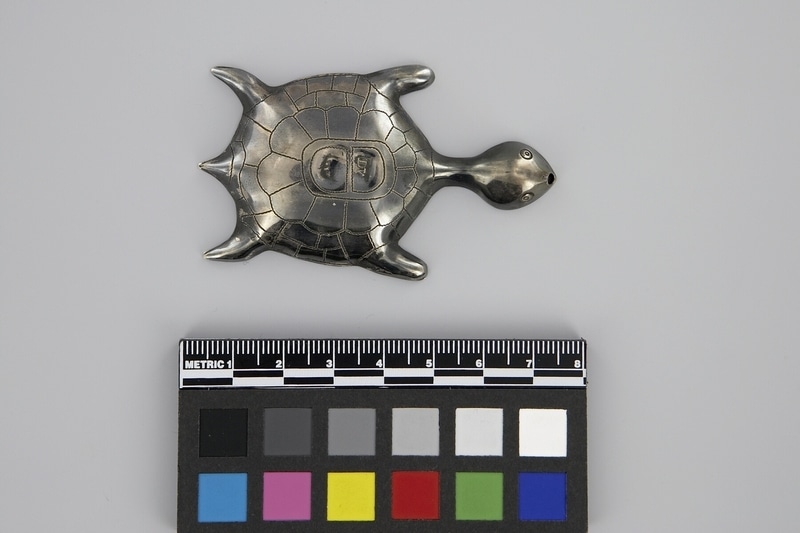Turtle Pendant Item Number: 1590/51 from the MOA: University of British Columbia


Description
Turtle with engraved pattern on back. Two cartouches on centre of back. Maker's mark in one; mark in other indecipherable. Hole in nose. Black tarnish covers object.
History Of Use
Initially, the main source of silver was British, French and Spanish coins. Most ornaments were produced by silversmiths of European origin in North America and Europe, and were actively traded only from 1760 to 1821. by the mid-18th century silver objects were produced in New England, Quebec and Montreal. Animal imagery is a significant part of woodland first nations tradition, but no documented instance has been found of the use of animal effigies in trade. The place of effigies in woodlands culture is not known.
Windsor dealth with the XY Company. In 1798 a group of Montreal traders formed the New North West Company to compete wit the North West Company (NWC). The former was dubbed the XY Company after the insignia on its kegs and bales of furs. When former NWC partner, Alexander Mackenzie, joined the XY Company, the name was changed to Alexander Mackenzie and Company. In 1804 the two companies merged under the NorthWest Company name. Newman, Peter Co. "Empire of the Bay", Viking 1985.
Cultural Context
personal ornamentation
Iconographic Meaning
The Iroquois legend of the turtle explains that the Earth was formed from a lump of mud on the turtle's back. See Frederickson, page 59.
Item History
- Made by David Windsor (Maker) in Canada ? or USA ? between 1760 and 1821
- Owned by Kathleen E. Reif before September 9, 1993
- Received from Kathleen E. Reif (Donor) on September 9, 1993
What
Who
- Culture
- Eastern Woodlands
- Creator
- David Windsor (Maker)
- Previous Owner
- Kathleen E. Reif
- Received from
- Kathleen E. Reif (Donor)
Where
- Holding Institution
- MOA: University of British Columbia
- Made in
- Canada ? or USA ?
When
- Creation Date
- between 1760 and 1821
- Ownership Date
- before September 9, 1993
- Acquisition Date
- on September 9, 1993
Other
- Item Classes
- metalwork
- Condition
- good
- Current Location
- Case 45
- Accession Number
- 1590/0051